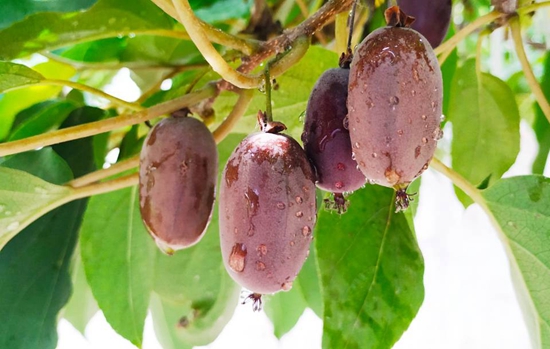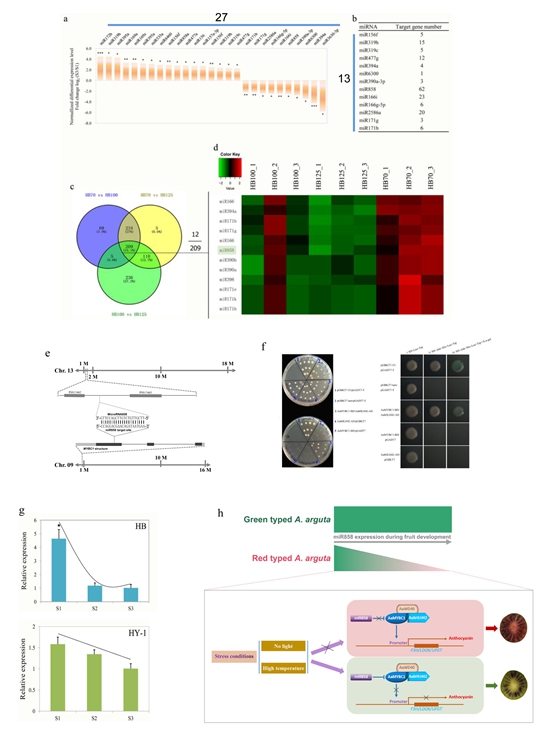Multi-omics Analysis Reveals Fruit Coloration Mechanism in Actinidia Arguta
Recently, an article entitled MicroRNA858 Negatively Regulates Anthocyanin Biosynthesis by Repressing AaMYBC1 Expression in Kiwifruit (Actinidia arguta) completed by Prof. Jinbao Fang’s lab at Zhengzhou Fruit Research Institute of CAAS was published in the international botanical journal Plant Science (5-year if = 4.253). This work mainly focuses on the genomic localization and functional verification of key regulator. Additionally, it provides the molecular basis for genetic improvement of kiwifruit color quality.

Actinidia arguta,Ruby Star
China is the origin of Actinidia genus with abundant germplasm resources. The larger cultivation proportion is green kiwifruit (90%) over red. Researchers explored the molecular mechanism of red fruit coloration in order to improve its genetic resources. Anthocyanin accumulation is responsible for the red color in kiwifruit, but the mechanism underlying the anthocyanin biosynthesis is largely unclear. The whole-red A. arguta fruit is a good starting point for coloration experiments. A key structural gene AaLDOX encoding leucoanthocyanidin dioxygenase plays an important role in anthocyanin biosynthetic pathway in A. arguta based on transcriptome analysis of fruits at different developmental stages (Li et al., 2018). Non-targeted metabolome analysis revealed cyanidin, delphinidin, and derivative anthocyanin as the main pigments for red fruit in A. arguta. In addition, miR858, highly expressed at the green-fruit stage, negatively regulated anthocyanin biosynthesis by targeting R2R3-AaMYBC1 based on combined analysis of small RNA sequencing and transcriptome results (Li et al., 2019). A anthocyanin-regulatory model of fruit response to external environmental factors was established from the results of genomic localization, normal or mutated target sites-mediated transient co-transformation in tobacco, yeast two-hybrid system, transient over-expression, gene silencing and environment induced-differential analysis to reveal the regulatory role of miR858 in anthocyanin biosynthesis of A. arguta (Li et al., 2020). All in all, the research team explained the molecular mechanism of fruit coloration based on multi-omics analysis (see figure below). It is worth mentioning that this research team has successfully constructed approximately 2000 artificial hybrid populations of red-green A. arguta, based on which the population genetics research is under way.
The study was supported by the National Natural Science Foundation of China (31401825), the National Key R&D Program of China (2019YFD1000802), and the Special Funds for Science and Technology Innovation Project of the Chinese Academy of Agricultural Sciences (CAAS-ASTIP-2018-ZFRI).

Figure Gene mining and functional identification based on multi-omics analysis.
The URL for relevant article are shown below:
https://www.sciencedirect.com/science/article/pii/S0168945220300789
https://journals.plos.org/plosone/article?id=10.1371/journal.pone.0217480
https://www.sciencedirect.com/science/article/pii/S0378111918300295
By Yukuo Li (liyukuo@caas.cn)
-
 Apr 18, 2024Opening Ceremony of the Training Workshop on Wheat Head Scab Resistance Breeding and Pest Control in Africa Held in CAAS
Apr 18, 2024Opening Ceremony of the Training Workshop on Wheat Head Scab Resistance Breeding and Pest Control in Africa Held in CAAS -
 Apr 03, 2024IPPCAAS Co-organized the Training Workshop on Management and Application of Biopesticides in Nepal
Apr 03, 2024IPPCAAS Co-organized the Training Workshop on Management and Application of Biopesticides in Nepal -
 Mar 28, 2024Delegation from the School of Agriculture and Food Science of University College Dublin, Ireland Visit to IAS, CAAS
Mar 28, 2024Delegation from the School of Agriculture and Food Science of University College Dublin, Ireland Visit to IAS, CAAS -
 Mar 25, 2024Director of World Food Prize Foundation visited GSCAAS
Mar 25, 2024Director of World Food Prize Foundation visited GSCAAS -
 Mar 20, 2024Institute of Crop Sciences (ICS) and Syngenta Group Global Seeds Advance Collaborative Research in the Seed Industry
Mar 20, 2024Institute of Crop Sciences (ICS) and Syngenta Group Global Seeds Advance Collaborative Research in the Seed Industry
